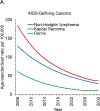Projected Cancer Incidence Rates and Burden of Incident Cancer Cases in HIV-Infected Adults in the United States Through 2030
- PMID: 29801099
- PMCID: PMC6329294
- DOI: 10.7326/M17-2499
Projected Cancer Incidence Rates and Burden of Incident Cancer Cases in HIV-Infected Adults in the United States Through 2030
Abstract
Background: Persons living with HIV (PLWH) have an elevated risk for certain types of cancer. With modern antiretroviral therapy, PLWH are aging and cancer rates are changing.
Objective: To project cancer incidence rates and burden (number of new cancer diagnoses) among adult PLWH in the United States through 2030.
Design: Descriptive.
Setting: HIV/AIDS Cancer Match Study to project cancer rates and HIV Optimization and Prevention Economics model to project HIV prevalence.
Participants: HIV-infected adults.
Measurements: Projected cancer rates and burden among HIV-infected adults in the United States by age during 2006 to 2030 for AIDS-defining cancer (ADC)-that is, Kaposi sarcoma, non-Hodgkin lymphoma, and cervical cancer-and certain types of non-AIDS-defining cancer (NADC). All other cancer types were combined.
Results: The proportion of adult PLWH in the United States aged 65 years or older is projected to increase from 8.5% in 2010 to 21.4% in 2030. Age-specific rates are projected to decrease through 2030 across age groups for Kaposi sarcoma, non-Hodgkin lymphoma, cervical cancer, lung cancer, Hodgkin lymphoma, and other cancer types combined, and among those aged 65 years or older for colon cancer. Prostate cancer rates are projected to increase. The estimated total cancer burden in PLWH will decrease from 8150 cases in 2010 (2730 of ADC and 5420 of NADC) to 6690 cases in 2030 (720 of ADC and 5980 of NADC). In 2030, prostate cancer (n = 1590) and lung cancer (n = 1030) are projected to be the most common cancer types.
Limitation: Projections assume that current trends in cancer incidence rates, HIV transmission, and survival will continue.
Conclusion: The cancer burden among PLWH is projected to shift, with prostate and lung cancer expected to emerge as the most common types by 2030. Cancer will remain an important comorbid condition, and expanded access to HIV therapies and cancer prevention, screening, and treatment is needed.
Primary funding source: National Cancer Institute.
Conflict of interest statement
Figures







References
-
- Samji H, Cescon A, Hogg RS, Modur SP, Althoff KN, Buchacz K, et al.; North American AIDS Cohort Collaboration on Research and Design (NA-ACCORD) of IeDEA. Closing the gap: increases in life expectancy among treated HIV-positive individuals in the United States and Canada. PLoS One. 2013;8:e81355 [PMID: ] doi:10.1371/journal.pone.0081355 - DOI - PMC - PubMed
-
- Centers for Disease Control and Prevention. HIV/AIDS Surveillance Report, 2007. Vol.19 Atlanta: Centers for Disease Control and Prevention; 2009.
-
- Centers for Disease Control and Prevention. HIV/AIDS Surveillance Report, 2015. Vol. 27 Atlanta: Centers for Disease Control and Prevention; 2016.
Publication types
MeSH terms
Grants and funding
LinkOut - more resources
Full Text Sources
Other Literature Sources
Medical
